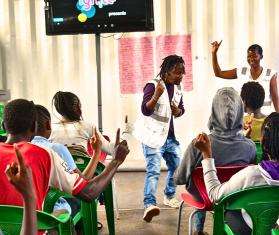Torrential rains caused a major landslide and subsequent flooding in Hpakant, a mining area in northern Kachin State, Myanmar, on July 4. Officials say 24 people are dead, but figures remain unclear. About 1,000 people who have lost their homes have sought refuge in local monasteries and a school. The local 25-bed government hospital has received dozens of injured and part of the hospital has also been flooded.
Doctors Without Borders/Médecins Sans Frontières (MSF) runs a clinic to for patients living with HIV and other sexually-transmitted diseases in this area, and is now distributing relief items, including soap, blankets, and mosquito nets, as well as food donated by the World Food Program. MSF is also providing support to the government hospital through the provision of medical supplies, and continues to monitor the situation closely, especially the condition of water and sanitation, and are ready to respond as necessary.
Spread of HIV/AIDS persists in Kachin State, throughout Myanmar
At its northernmost reaches, Kachin State borders China and comprises thick jungle, along with Myanmar’s largest mountains. The region contains people from many different ethnic groups, as well as numerous migrant workers attracted by large jade mines. Health issues, notably HIV/AIDS, are fuelled by a prevalence of brothels and opium dens, and compounded by a lack of accessible and affordable health services.
MSF runs eight clinics and numerous mobile clinics providing services in HIV/AIDS care, treatment and prevention activities such as harm-reduction for intravenous drug users, treatment for reproductive tract infection, tuberculosis, and malaria, as well as health education.
The situation for many people living with HIV in Myanmar is critical due to a severe lack of lifesaving antiretroviral treatment (ART). MSF currently provides ART to more than 11,000 people. That is the majority of all available treatment countrywide, but only a small fraction of what is urgently needed.
An estimated 240,000 people are currently infected with HIV in Myanmar. Of these, 76,000 are in urgent need of ART, but less than 20 percent of them receive it. Those who receive ART do so through the combined efforts of MSF, other international non-governmental organizations (NGOs) and the Government of Myanmar. For the remaining people, the private market offers little assistance as the most commonly used first-line treatment costs the equivalent of a month’s average wage. The lack of accessible treatment resulted in 25,000 AIDS-related deaths in 2007 and a similar number of people are expected to suffer the same fate this year, unless HIV/AIDS services—most importantly the provision of ART—are urgently scaled-up.
The Government of Myanmar and the international community need to mobilize quickly in order to address this situation. Currently, the government spends a mere 0.3 percent of the gross domestic product on health—the lowest amount worldwide—a small portion of which goes to HIV/AIDS. Likewise, overseas development aid for Myanmar is the second lowest per capita worldwide and few of the big international donors provide any resources to the country. Yet, 189 member states of the United Nations, including Myanmar, endorsed the Millennium Development Goals, including the aim to “achieve universal access to treatment for HIV/AIDS for all those who need it, by 2010.” As it stands, this is a far cry from becoming a reality in Myanmar.



